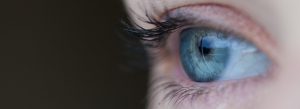Uveitis represents a heterogeneous group of diseases, characterised by intraocular inflammation, including non-infectious uveitis. The term uveitis technically describes inflammation of the uvea, the vascular tunic of the eye that anatomically includes the iris, ciliary body and choroid. Since intraocular inflammation can affect surrounding tissues, the clinical term uveitis can include inflammation of the retina (retinitis), optic disc (papillitis) and vitreous (vitritis).1
5-10% of vision problems in the world's population is caused by uveitis, which is therefore a significant cause of eye disease.
L'uveitis can be classified according to the aetiology or the anatomical ocular site affected by the malattia.1

Classification by aetiology1
- -Infectious uveitis due to tuberculosis, syphilis or toxoplasma; requires treatment of the underlying infection with antimicrobials, sometimes accompanied by corticosteroids to reduce the severity of the inflammation.
- -Non-infectious uveitis, which is believed to be autoimmune (or at least autoinflammatory); most treatments are based on corticosteroids or other immunosuppressants.
- -Masked uveitis, in which the primary disease is not inflammatory, such as that observed in intraocular lymphoma. The treatment of masked uveitis is specific to the cause of its onset.
Classification by anatomy1
Anatomically, uveitis is classified according to the primary site of inflammation:
- -Anterior uveitis, in which the primary site is the anterior chamber, iris and pars plicata
- -Uveitis intermedia, in which the primary site is the vitreous body and the pars plana
- -Uveitis posterior, in which the primary site is the retina or choroid
- -Panuveitis, in which inflammation is distributed throughout all ocular districts
Symptoms
The symptoms of uveitis depend on the site of inflammation, but in general can be identified as:
- -reddening
- -pain
- -sensitivity to light
- -floaters or flying flies
- -blurred vision
Most causes of non-infectious uveitis appear to be autoimmune or auto-inflammatory in nature and may be associated with systemic conditions characterised by dysregulation of the immune system or the inflammasome (a multi-protein sensor that activates innate immunity after detecting pathogens). Diseases associated with uveitis include ankylosing spondylitis, of which uveitis is the most common extra-articular complication, affecting up to 50% of patients. Similarly, uveitis is a significant extra-articular manifestation of inflammatory bowel disease and reactive arthritis, although less common than in ankylosing spondylitis.
The autoimmune causes of non-infectious uveitis are to be found in an inappropriate immune response, mediated by T lymphocytes, which recognise and attack the cells of the steorganism rather than foreign pathogens.
Treatment
The treatment of non-infectious uveitis is chosen on the basis of the location of the inflammation.1
Treatment of non-infectious anterior uveitis1
- -Topical corticosteroids such as dexamethasone 0.1% or prednisolone acetate 1%
- -Midriatics such as cyclopentolate at 1%
- -Subconjunctival injection of corticosteroids or short course of oral corticosteroids in severe cases
Treatment of intermediate, posterior or panuveitis non-infectious uveitis1
- -Systemic treatment with corticosteroids is common as first-line therapy. Failure to achieve therapeutic goals indicates the need for alternative or additional treatment, such as the introduction of a second-line immunosuppressant or additional local therapies. The use of biological therapies is effective and is commonly used as third-line treatment. In ocular inflammatory diseases of the posterior segment, intravitreal injections of corticosteroid drugs are one of the main therapeutic strategies used in clinical practice. Among intravitreal implants, the slow-release device based on fluocinolone acetonide.
- -Local treatment is usually based on corticosteroids. These drugs are effective, but have significant rates of increased intraocular pressure and cataract formation. Despite these limitations, they are very useful especially in the treatment of unilateral or asymmetrical diseases where they can mitigate the required level of systemic immunosuppression.
Bibliography:
Dr. Carmelo Chines
Direttore responsabile
